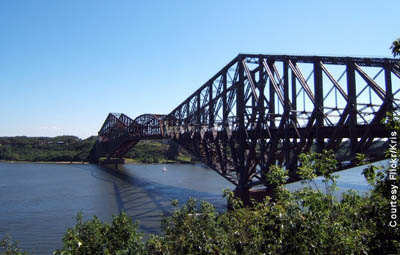Quebec Bridge
46 44 45.6 N
71 17 17.3 W
At the time of construction, the Quebec Bridge was the longest span (549 meters) cantilever bridge in the world.

It took three tries and cost 89 lives, but the city of Quebec was determined to compete with provincial rival Montreal for commercial rail traffic in the late 19th century. The solution was a rail bridge across the St. Lawrence River requiring a single cantilever span 1,800 feet long - the longest ever attempted.
A combination of design flaws and management errors caused the first bridge to collapse before completion in 1907. The disaster led to new research and testing methods and better designer-contractor coordination. In 1916, a redesigned 5,000-ton center span was jacked into place from barges, but as thousands of spectators watched, it too crashed into the river when a jack bearing failed. Undaunted, the city and its engineers made a third attempt, duplicating the second design. A year later, the bridge was finally complete. It remains the longest cantilever railroad span ever built.
Facts
- The 1,800-foot cantilever span supports its weight 150 feet above the water to allow ocean-going vessels to pass below.
- The bridge is immense, not only in length and weight but in width. At 67 feet wide, it can accommodate two sets of railway tracks, two sets of streetcar tracks and two roadways.
- The reconstructed bridge was one of the first large-scale uses of a new nickel alloy steel that could support stresses 40 times greater than carbon steel.
- The redesigned span weighed two and a half times as much as the first bridge, demonstrating the inadequacy of the original design.
Resources
- John Tarkov, "A Disaster in the Making," American Heritage of Invention & Technology 1 (Spring 1986): 10-17.

